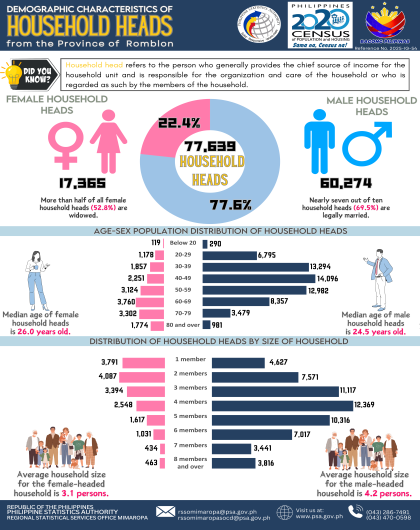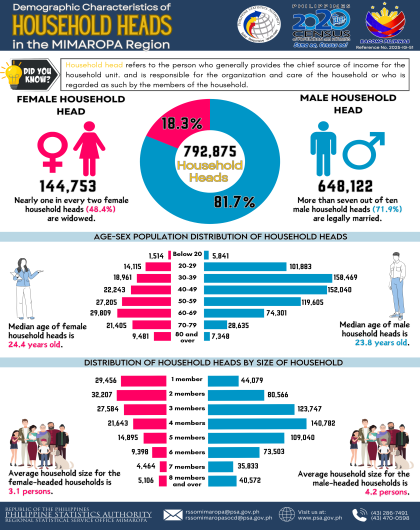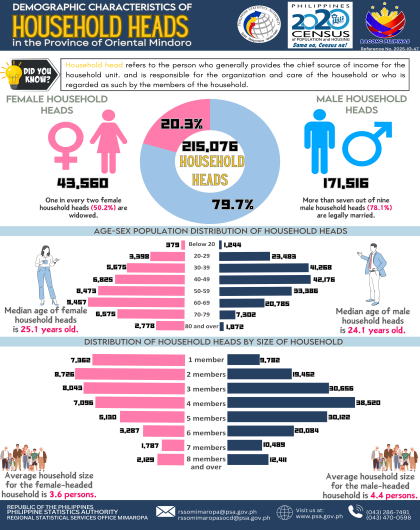Nearly three in every eight MIMAROPAns reaches high school level
In the 2020 CPH, the highest educational attainment was asked for all household population aged five years and over. The census revealed that 37.2 percent had reached or completed at most high school or secondary level (graduate: 18.3%, and undergraduate: 18.9%), 35.2 percent had reached or completed at most elementary level (graduate: 12.1%, and undergraduate: 23.0%), and 18.0 percent had reached or completed at most college level (graduate: 9.8%, and undergraduate: 8.2%). Meanwhile, 0.3 percent had reached or completed post baccalaureate level. (Figure 1 and Table 1)
More females attain higher levels of education than males
In 2020, more than one in every five females (20.6%) in the region has been pursuing a college undergraduate degree program or already college graduate. Meanwhile, more than three in every 20 males (15.5%) were either a college undergraduate or completed their baccalaureate degrees. (Table 1)
Similarly, more females (four in every 1,000 females) than males (three in every 1,000 males) had completed post baccalaureate courses. (Table 1)
About two in every three children aged 5 to 9 years has elementary education under the K to 12 Curriculum
Nearly two-thirds (65.3%) of the 356,104 children in the MIMAROPA Region aged
On the other hand, nearly three in every five (58.0%) of the 357,807 children aged
Moreover, nearly half or 48.3 percent of the 338,454 household population aged 15 to 19 years had reached or completed JHS, while 28.9 percent reached or completed
Of the household population aged 20 to 24 years, 42.2 percent had reached or completed college education. In addition, more than a quarter (25.7%) of this age group had reached or completed High School and nearly three in every 20 or 13.4 percent of the household population reached or completed Elementary under the Old Curriculum. Meanwhile, almost 13.4 percent of this household population enrolled in or graduated from the K to 12 Program. (Table 2b)
Finally, more than seven in every 20 or 35.9 percent of the household population 25 years and over had reached or completed High School, nearly a third or
Based on the 2020 CPH, there were 282,037 MIMAROPAns who graduated college. Of these, 26.2 percent had a degree in Education Science, 22.2 percent obtained a degree in Business Administration and Law, and 11.1 percent got a degree in Engineering, Manufacturing, and Construction. Completing the top five academic degrees taken by college graduates in the region were Services (9.9%), and Information and Communication Technologies (8.5%). (Table 3 and Figure 2)
Males prefer Engineering, Manufacturing, and Construction courses; females opt for Education Science courses
The three most popular courses attended or completed by 114,799 male academic degree holders were: Engineering, Manufacturing, and Construction (22.0%), Business Administration and Law (16.9%), and Education Science (14.0%). On the other hand, among 167,238 female college graduates, the three most popular academic degrees courses were: Education Science (34.6%), Business
More females than males pursue post-baccalaureate education
Among the 6,195 MIMAROPAns who had reached or completed at most postbaccalaureate level of education (i.e., master’s and doctorate degrees), more than three in every five or 60.9 percent were females, while 39.1 percent were males.
Education Science was the most common field among those who pursued postbaccalaureate degrees, comprising of 2,574 persons (41.5%). Moreover, this was also the post-baccalaureate program taken by three in every ten male MIMAROPAns and nearly half or 48.8 percent of female MIMAROPAns.
Completing the top five most popular post-baccalaureate programs were Health and Welfare (20.1%), Business Administration and Law (18.3%), Arts and Humanities
TECHNICAL NOTES
I. Introduction
The Philippine Statistics Authority conducted the 2020 Census of Population and Housing (2020 CPH) in September 2020, with 01 May 2020 as reference date.
The 2020 CPH was the 15th census of population and 7th census of housing that was undertaken in the Philippines since the first census in 1903. It was designed to take inventory of the total population and housing units in the country and collect information about their characteristics.
The Philippine Standard Geographic Codes as of March 2022 was used for the disaggregation of geographic levels of the 2020 CPH.
II. Data Collection
Data on highest grade/year completed furnish information on the educational skills and qualifications of the population. The data will be used to compare with the future requirements of manpower for various types of economic activities.
The statistics presented in this report were based on the information provided by the respondent or any responsible household member who may provide accurate answers to the questions and give correct information about all the household members; hence, it should be used with caution.
III. Methodology
The population and housing censuses in the Philippines are conducted on a “de jure” basis, wherein a person is counted in the usual place of residence or the place where the person usually resides. The enumeration of the population and collection of pertinent data in the 2020 CPH referred to all living persons as of 01 May 2020.
For the 2020 CPH, Highest Grade/Year Completed was asked for all household members five years and over. ““What is the highest grade/year completed by _________?”.
IV. Concepts and Definition of Terms
A household is a social unit consisting of a person living alone or a group of persons who sleep in the same housing unit and have a common arrangement in the preparation and consumption of food.
Household population comprises of persons who belong to a household.
Sex is the biological and physiological reality of being a male or female.
Age refers to interval of time between the person’s date of birth and his/her last birthday prior to the census reference date. It is expressed in completed years or whole number.
Highest grade/year completed refers to the highest grade or year completed in school, college, or university as of 01 May 2020. This may be any one of the specific grades or years in elementary, high school, K to 12 Program, and college. It may also be special needs education program, second-chance education program, or any of the post-secondary, short-cycle tertiary, college, and post baccalaureate courses.
In 2011, the Department of Education (DepEd) implemented the K to 12 Program. Under this program, the education of a person starts in kindergarten, followed by an elementary education of six years from Grade 1 to Grade 6, junior high school education of four years from Grade 7 to Grade 10, and senior high school education of two years from Grade 11 to Grade 12.
Below are the career tracks for Senior High School (Grades 11 and 12) and their corresponding strands:
Track | Strand |
Academic Track |
|
Arts and Design Track |
|
Sports Track | N/A |
Technology and Livelihood Education (TLE) and |
|
Track | Strand |
Technical-Vocational- Livelihood (TVL) Track |
|
The Old Curriculum covers preschool, six to seven years in elementary from Grade 1 to Grade 6 or Grade 7, and four years in high school from 1st year to 4th year.
Inclusive/Special Needs Education (SPED) Program is designed to facilitate learning by individuals who, for a wide variety of reasons, require additional support and adaptive pedagogical methods in order to participate and meet learning objectives in an education program. Reasons may include (but are not limited to) disadvantages in physical, behavioral, intellectual, emotional and social capacities. For purposes of the 2020 CPH, this includes gifted or talented individuals.
Special Needs Education Program in Primary Level (elementary) includes programs suited to individuals with special needs that are designed to provide systematic teaching and learning in the fundamental skills of reading, writing, and mathematics, irrespective of the age of the participant.
Special Needs Education Program in Secondary Level (high school) includes programs suited to individuals with special needs that are designed to build on the fundamental teaching and learning processes that begin at elementary level and/or provide skills relevant to employment.
Second-Chance Education Programs in Primary Level refers to the program that usually targets individuals who: (1) left school before completing primary education, allowing them to re-enter the education system and complete primary education or (2) completed primary education but wish to enter an education program or occupation for which they are not yet qualified.
Second-Chance Education Programs in Secondary Level refers to the program that usually targets individuals who: (1) left education after completing primary education but before completing lower secondary education, allowing them to re-enter the education system and complete a lower secondary education program or (2) completed lower secondary education but wish to enter an education program or occupation for which they are not yet qualified.
Post-secondary or Post-secondary Non-tertiary Education provides learning experiences building on secondary education, preparing graduates for labor market entry as well as tertiary education. Programs are not considered to be tertiary education and are typically vocational and terminal programs that prepare graduates for the labor market.
Short-cycle tertiary education captures the lowest level of tertiary education and also includes advanced technical and vocational education and training (TVET). Programs at this level have more complex contents than programs in senior high school and post-secondary non-tertiary education, but are shorter and less theoretically-oriented than a Bachelor's program. Although they are usually designed to prepare for employment, they may give credit for transfer into a Bachelor’s or Master’s degree.
Bachelor-Level Education is designed to provide participants with intermediate academic and/or professional knowledge, skills and competencies, leading to a first degree equivalent qualification. It typically has duration of three to four years of full-time study at the tertiary level. Traditionally offered by universities and equivalent tertiary educational institutions, it does not necessarily require the preparation of a substantive thesis or dissertation.
Post-baccalaureate course refers to any course for which an undergraduate degree or bachelor’s degree is required.
Master-Level Education is designed to provide participants with advanced academic and/or professional knowledge, skills and competencies, leading to a second degree or equivalent qualification and has a substantial research component but do not yet lead to the award of a doctoral qualification.
Doctoral-Level Education is designed primarily to lead to an advanced research qualification and devoted to advanced study and original research. Typically offered by research-oriented tertiary educational institutions such as universities, doctoral programs exist in both academic and professional fields. The theoretical duration of this program is three years full-time in most countries, although the actual time that students take to complete the program is typically longer.






